A Method for Estimating Annual Cumulative Soil/Ecosystem Respiration and CH4 Flux from Sporadic Data Collected Using the Chamber Method
Abstract
:1. Introduction
2. Methods
2.1. Data Collection and Screening
2.2. Development and Testing of AF Estimation Equations
2.2.1. Data Preparation for the Development and Testing of the Equations for Annual Soil/Ecosystem Respiration and CH4 Cumulative Fluxes (AFCO2 and AFCH4): Observed Monthly Cumulative Flux Calculations
2.2.2. Data Preparation for the Development and Testing of the AFCO2 and AFCH4 Equations: Observed AF Calculations
2.2.3. Development of the Estimation Equations for AFCO2 and AFCH4
2.2.4. Testing the Estimation Accuracy of the Equations
2.2.5. Comparison of Estimating Accuracies of Different Ecosystem Types and Interface Types
2.2.6. Testing the Present Annual Flux Estimation Method with Eddy Covariance Data
2.3. Statistical Analysis
3. Results
3.1. Relationships between Observed Annual and Monthly Flux
3.2. Comparison of Different Types of Equations
3.3. Effects of Sampling Frequency on AF Estimation
3.4. Effects of Sampling Months on AF Estimation
3.5. Simulative Accuracies of Different Ecosystem Types and Interface Types
3.6. Testing Simulation Equation Using Eddy Covariance Data
4. Discussion
4.1. Feasibility of Estimating AF Using Low-Frequency Flux Data Observations
4.2. Selection of Sampling Months
4.3. Uncertainties
5. Conclusions
Supplementary Materials
Author Contributions
Funding
Acknowledgments
Conflicts of Interest
References
- Ciais, P.; Sabine, C.; Bala, G.; Bopp, L.; Brovkin, V.; Canadell, J.; Chhabra, A.; DeFries, R.; Galloway, J.; Heimann, M.; et al. Carbon and other biogeochemical cycles. In Climate Change 2013: The Physical Science Basis: Contribution of Working Group I to the Fifth Assessment Report of the Intergovernmental Panel on Climate Change; Stocker, T.F., Qin, D., Plattner, G.K., Tignor, M., Allen, S.K., Boschung, J., Nauels, A., Xia, Y., Bex, V., Midgley, P.M., Eds.; Cambridge University Press: Cambridge, UK; New York, NY, USA, 2013; pp. 465–570. [Google Scholar]
- Lal, R. Soil carbon sequestration impacts on global climate change and food security. Science 2004, 304, 1623–1627. [Google Scholar] [CrossRef] [PubMed]
- Zhao, Z.; Peng, C.; Yang, Q.; Meng, F.; Song, X.; Chen, S.; Epule, T.E.; Li, P.; Zhu, Q. Model prediction of biome-specific global soil respiration from 1960 to 2012. Earth’s Future 2017, 5, 715–729. [Google Scholar] [CrossRef]
- Hashimoto, S.; Carvalhais, N.; Ito, A.; Migliavacca, M.; Nishina, K.; Reichstein, M. Global spatiotemporal distribution of soil respiration modeled using a global database. Biogeosciences 2015, 12, 4121–4132. [Google Scholar] [CrossRef] [Green Version]
- Myhre, G.; Shindell, D.; Bréon, F.M.; Collins, W.; Fuglestvedt, J.; Huang, J.; Koch, D.; Lamarque, J.F.; Lee, D.; Mendoza, B.; et al. Anthropogenic and Natural Radiative Forcing. In Climate change 2013: The physical Science Basis: Contribution of Working Group I to the Fifth Assessment Report of the Intergovernmental Panel on Climate Change; Stocker, T.F., Qin, D., Plattner, G.K., Tignor, M., Allen, S.K., Boschung, J., Nauels, A., Xia, Y., Bex, V., Midgley, P.M., Eds.; Cambridge University Press: Cambridge, UK; New York, NY, USA, 2013; pp. 659–740. [Google Scholar]
- Van den Pol-van Dasselaar, A.; van Beusichem, M.L.; Oenema, O. Effects of soil moisture content and temperature on methane uptake by grasslands on sandy soils. Plant Soil 1998, 204, 213–222. [Google Scholar] [CrossRef]
- Dlugokencky, E.J.; Nisbet, E.G.; Fisher, R.; Lowry, D. Global atmospheric methane: Budget, changes and dangers. Philos. Trans. R. Soc. A Math. Phys. Eng. Sci. 2011, 369, 2058–2072. [Google Scholar] [CrossRef] [PubMed]
- Bond-lamberty, B.; Thomson, A. A global database of soil respiration data. Biogeosciences 2010, 7, 1915–1926. [Google Scholar] [CrossRef] [Green Version]
- Oertel, C.; Matschullat, J.; Zurba, K.; Zimmermann, F.; Erasmi, S. Greenhouse gas emissions from soils—A review. Chem. Erde-Geochem. 2016, 76, 327–352. [Google Scholar] [CrossRef]
- Lundegardh, H. Carbon dioxide evolution of soil and crop growth. Soil Sci. 1927, 23, 417–453. [Google Scholar] [CrossRef]
- Savage, K.; Phillips, R.; Davidson, E. High temporal frequency measurements of greenhouse gas emissions from soils. Biogeosciences 2014, 11, 18277–18308. [Google Scholar] [CrossRef]
- Görres, C.M.; Kammann, C.; Ceulemans, R. Automation of soil flux chamber measurements: Potentials and pitfalls. Biogeosci. Disc. 2016, 13, 1949–1966. [Google Scholar] [CrossRef]
- Yao, Z.; Zheng, X.; Xie, B.; Liu, C.; Mei, B.; Dong, H.; Butterbach-Bahl, K.; Zhu, J. Comparison of manual and automated chambers for field measurements of N2O, CH4, CO2 fluxes from cultivated land. Atmos. Environ. 2009, 43, 1888–1896. [Google Scholar] [CrossRef]
- Lai, D.Y.F.; Roulet, N.T.; Humphreys, E.R.; Moore, T.R.; Dalva, M. The effect of atmospheric turbulence and chamber deployment period on autochamber CO2 and CH4 flux measurements in an ombrotrophic peatland. Biogeosciences 2012, 9, 3305–3322. [Google Scholar] [CrossRef]
- Hoffmann, M.; Wirth, S.J.; Beßler, H.; Engels, C.; Jochheim, H.; Sommer, M.; Augustin, J. Combining a root exclusion technique with continuous chamber and porous tube measurements for a pin-point separation of ecosystem respiration in croplands. J. Plant Nutr. Soil Sci. 2018, 181, 41–50. [Google Scholar] [CrossRef]
- Teramoto, M.; Liang, N.; Takagi, M.; Zeng, J.; Grace, J. Sustained acceleration of soil carbon decomposition observed in a 6-year warming experiment in a warm-temperate forest in southern Japan. Sci. Rep. 2016, 6, 35563. [Google Scholar] [CrossRef]
- Courtois, E.A.; Stahl, C.; Burban, B.; Van den Berge, J.; Berveiller, D.; Brechet, L.; Soong, J.L.; Arriga, N.; Penuelas, J.; Janssens, I.A. Automatic high-frequency measurements of full soil greenhouse gas fluxes in a tropical forest. Biogeosciences 2019, 16, 785–796. [Google Scholar] [CrossRef] [Green Version]
- Scholze, M.; Buchwitz, M.; Dorigo, W.; Guanter, L.; Shaun, Q. Reviews and syntheses: Systematic earth observations for use in terrestrial carbon cycle data assimilation systems. Biogeosciences 2017, 14, 3401–3429. [Google Scholar] [CrossRef]
- Papale, D.; Valentini, R. A new assessment of European forests carbon exchanges by eddy fluxes and artificial neural network spatialization. Glob. Chang. Biol. 2010, 9, 525–535. [Google Scholar] [CrossRef]
- Keenan, T.; Maria, S.J.; Lloret, F.; Ninyerola, M.; Sabate, S. Predicting the future of forests in the Mediterranean under climate change, with niche- and process-based models: CO2 matters. Glob. Chang. Biol. 2011, 17, 565–579. [Google Scholar] [CrossRef]
- Mcguire, A.D.; Sitch, S.; Clein, J.S.; Dargaville, R.; Esser, G.; Foley, J.; Heimann, M.; Joos, F.; Kaplan, J.; Kicklighter, D.W. Carbon balance of the terrestrial biosphere in the twentieth century: Analyses of CO2, climate and land use effects with four process—Based ecosystem models. Glob. Biogeochem. Cycles 2001, 15, 183–206. [Google Scholar] [CrossRef]
- Zhao, Y.; Ciais, P.; Peylin, P.; Viovy, N. How errors on meteorological variables impact simulated ecosystem fluxes: A case study for six French sites. Biogeosciences 2012, 9, 2537–2564. [Google Scholar] [CrossRef]
- Ruimy, A.; Saugier, B.; Dedieu, G. Methodology for the estimation of terrestrial net primary production from remotely sensed data. J. Geophys. Res. Atmos. 1994, 99, 5263–5283. [Google Scholar] [CrossRef]
- Estes, L.; Chen, P.; Debats, S.; Evans, T.; Ferreira, S.; Kuemmerle, T.; Ragazzo, G.; Sheffield, J.; Wolf, A.; Wood, E. A large-area, spatially continuous assessment of land cover map error and its impact on downstream analyses. Glob. Chang. Biol. 2017, 24, 322–337. [Google Scholar] [CrossRef] [PubMed]
- Demarty, M.; Bastien, J.; Tremblay, A. Carbon dioxide and methane annual emissions from two boreal reservoirs and nearby lakes in Quebec, Canada. Biogeosci. Discuss. 2009, 6, 2939–2963. [Google Scholar] [CrossRef] [Green Version]
- Liu, Y.; Yan, C.; Matthew, C.; Wood, B.; Hou, F. Key sources and seasonal dynamics of greenhouse gas fluxes from yak grazing systems on the Qinghai-Tibetan Plateau. Sci. Rep. 2017, 7, 40857. [Google Scholar] [CrossRef]
- Huang, Y. Study on carbon budget in terrestrial and marginal sea ecosystems of China. Bull. Chin. Acad. Sci. 2002, 17, 104–107. [Google Scholar]
- Jian, J.; Steele, M.K.; Thomas, R.Q.; Day, S.D.; Hodges, S.C. Constraining estimates of global soil respiration by quantifying sources of variability. Glob. Chang. Biol. 2018, 24, 4143–4159. [Google Scholar] [CrossRef]
- Xiao, J.; Zhuang, Q.; Law, B.E.; Baldocchi, D.D.; Chen, J.; Richardson, A.D.; Melillo, J.M.; Davis, K.J.; Hollinger, D.Y.; Wharton, S.; et al. Assessing net ecosystem carbon exchange of U.S. Terrestrial ecosystems by integrating eddy covariance flux measurements and satellite observations. Agric. Forest Meteorol. 2011, 151, 60–69. [Google Scholar] [CrossRef]
- FLUXNET2015 Dataset. Available online: https://fluxnet.fluxdata.org/data/fluxnet2015-dataset/ (accessed on 7 May 2018).
- R Core Team. R: A Language and Environment for Statistical Computing. R Foundation for Statistical Computing; R Core Team: Vienna, Austria, 2017; Available online: https://www.R-project.Org (accessed on 17 January 2019).
- Robinson, D.; Hayes, A. Broom: Convert Statistical Analysis Objects into Tidy Tibbles. R Package Version 0.5.1. 2018. Available online: https://cran.R-project.Org/package=broom (accessed on 17 January 2019).
- Wickham, H.; Francois, R.; Henry, L.; Müller, K. Dplyr: A Grammar of Data Manipulation. R Package Version 0.7.5. 2018. Available online: https://cran.R-project.Org/package=dplyr (accessed on 17 January 2019).
- Canty, A.; Ripley, B. Boot: Bootstrap r (s-plus) Functions. R Package Version 1.3-20. 2017. Available online: https://mirrors.tuna.tsinghua.edu.cn/CRAN/bin/windows/contrib/3.3/boot_1.3-20.zip (accessed on 17 January 2019).
- Peterson, B.G.; Carl, P. Performanceanalytics: Econometric Tools for Performance and Risk Analysis. R Package Version 1.5.2. 2018. Available online: https://mirrors.tuna.tsinghua.edu.cn/CRAN/bin/windows/contrib/3.4/PerformanceAnalytics_1.5.2.zip (accessed on 22 June 2019).
- Wickham, H. Ggplot2: Elegant Graphics for Data Analysis; Springer: New York, NY, USA, 2016. [Google Scholar]
- Kassambara, A. Ggpubr: ‘Ggplot2’ Based Publication Ready Plots. R Package Version 0.1.6. 2017. Available online: https://cran.R-project.Org/package=ggpubr (accessed on 17 January 2019).
- Bond-Lamberty, B.P.; Thomson, A.M. A Global Database of Soil Respiration Data, Version 4.1; ORNL Distributed Active Archive Center: Oak Ridge, TN, USA, 2018. [Google Scholar]
- Site Summary. Available online: https://fluxnet.fluxdata.org/sites/site-summary/ (accessed on 25 June 2019).
- Savage, K.E.; Davidson, E.A. A comparison of manual and automated systems for soil CO2 flux measurements: Trade-offs between spatial and temporal resolution. J. Exp. Bot. 2003, 54, 891–899. [Google Scholar] [CrossRef]
- Chen, S.; Zou, J.; Hu, Z. Measurements and modeling of soil respiration in terrestrial ecosystems. Ecol. Environ. Sci. 2017, 26, 1985–1996. [Google Scholar]
- Yu, G.; Zheng, Z.; Wang, Q.; Fu, Y.; Zhuang, J.; Sun, X.; Wang, Y. Spatiotemporal pattern of soil respiration of terrestrial ecosystems in China: The development of a geostatistical model and its simulation. Environ. Sci. Technol. 2010, 44, 6074–6080. [Google Scholar] [CrossRef]
- Chen, S.; Huang, Y.; Xie, W.; Zou, J.; Lu, Y.; Hu, Z. A new estimate of global soil respiration from 1970 to 2008. Chin. Sci. Bull. 2013, 58, 4153–4160. [Google Scholar] [CrossRef] [Green Version]
- Jian, J.; Steele, M.K.; Day, S.D.; Thomas, R.Q. Future global soil respiration rates will swell despite regional decreases in temperature sensitivity caused by rising temperature. Earth’s Future 2018, 6, 1539–1554. [Google Scholar] [CrossRef]
- Meng, L.; Hess, P.G.M.; Mahowald, N.M.; Yavitt, J.B.; Riley, W.J.; Subin, Z.M.; Lawrence, D.M.; Swenson, S.C.; Jauhiainen, J.; Fuka, D.R. Sensitivity of wetland methane emissions to model assumptions: Application and model testing against site observations. Biogeosciences 2011, 9, 2793–2819. [Google Scholar] [CrossRef]
- Lee, J.; McKnight, J.; Skinner, L.S.; Sherfy, A.; Tyler, D.; English, B. Soil carbon dioxide respiration in switchgrass fields: Assessing annual, seasonal and daily flux patterns. Soil Syst. 2018, 2, 13. [Google Scholar] [CrossRef]
- Lee, J.S. Monitoring soil respiration using an automatic operating chamber in a Gwangneung temperate deciduous forest. J. Ecol. Environ. 2011, 34, 411–423. [Google Scholar] [CrossRef]
- Morin, T.H.; Bohrer, G.; Stefanik, K.C.; Rey-Sanchez, A.C.; Matheny, A.M.; Mitsch, W.J. Combining eddy-covariance and chamber measurements to determine the methane budget from a small, heterogeneous urban floodplain wetland park. Agric. Forest Meteorol. 2017, 237, 160–170. [Google Scholar] [CrossRef]
- Zhang, G.B.; Ji, Y.; Ma, J.; Xu, H.; Cai, Z.C. Case study on effects of water management and rice straw incorporation in rice fields on production, oxidation, and emission of methane during fallow and following rice seasons. Soil Res. 2011, 49, 238–246. [Google Scholar] [CrossRef]
- Xu, X.; Riley, W.J.; Koven, C.D.; Billesbach, D.P.; Chang, R.Y.W.; Commane, R.; Euskirchen, E.S.; Hartery, S.; Harazono, Y.; Iwata, H. A multi-scale comparison of modeled and observed seasonal methane emissions in northern wetlands. Biogeosciences 2016, 13, 5043–5056. [Google Scholar] [CrossRef] [Green Version]
- Contosta, A.R.; Frey, S.D.; Cooper, A.B. Seasonal dynamics of soil respiration and N mineralization in chronically warmed and fertilized soils. Ecosphere 2011, 2, 1–21. [Google Scholar] [CrossRef]
- Sun, L.; Song, C.; Miao, Y.; Qiao, T.; Gong, C. Temporal and spatial variability of methane emissions in a northern temperate marsh. Atmos. Environ. 2013, 81, 356–363. [Google Scholar] [CrossRef]
- Liu, Y.; Han, S.J. Diurnal and seasonal variations in soil respiration in a temperate broad-leaved Korean pine forest, China. Appl. Mech. Mater. 2013, 295–298, 2318–2323. [Google Scholar] [CrossRef]
- Ma, L.; Zhong, M.; Zhu, Y.; Yang, H.; Johnson, D.A.; Rong, Y. Annual methane budgets of sheep grazing systems were regulated by grazing intensities in the temperate continental steppe: A two-year case study. Atmos. Environ. 2018, 174, 66–75. [Google Scholar] [CrossRef]
- Jammet, M.; Dengel, S.; Kettner, E.; Parmentier, F.J.W.; Wik, M.; Crill, P.; Friborg, T. Year-round CH4 and CO2 flux dynamics in two contrasting freshwater ecosystems of the subarctic. Biogeosciences 2017, 14, 5189–5216. [Google Scholar] [CrossRef]
- Perez-Quezada, J.F.; Brito, C.E.; Cabezas, J.; Galleguillos, M.; Fuentes, J.P.; Bown, H.E.; Franck, N. How many measurements are needed to estimate accurate daily and annual soil respiration fluxes? Analysis using data from a temperate rainforest. Biogeosciences 2016, 13, 6599–6609. [Google Scholar] [CrossRef] [Green Version]
- Eom, J.Y.; Jeong, S.H.; Chun, J.H.; Lee, J.H.; Lee, J.S. Long-term characteristics of soil respiration in a Korean cool-temperate deciduous forest in a monsoon climate. Anim. Cells Syst. 2018, 22, 100–108. [Google Scholar] [CrossRef]
- Guan, D.X.; Wu, J.B.; Zhao, X.S.; Han, S.J.; Yu, G.R.; Sun, X.M.; Jin, C.J. CO2 fluxes over an old, temperate mixed forest in northeastern China. Agric. Forest Meteorol. 2006, 137, 138–149. [Google Scholar] [CrossRef]
- Wang, M.; Li, Q.R.; Xiao, D.M.; Dong, B.L. Effects of soil temperature and soil water content on soil respiration in three forest types in changbai mountain. J. For. Res. 2004, 15, 113–118. [Google Scholar]
- Petersen, S.O.; Hoffmann, C.C.; Fer, C.M.S.; Blichermathiesen, G.; Elsgaard, L.; Kristensen, K.; Larsen, S.E.; Torp, S.B.; Greve, M.H. Annual emissions of CH4 and N2O, and ecosystem respiration, from eight organic soils in western Denmark managed by agriculture. Biogeosciences 2012, 9, 403–422. [Google Scholar] [CrossRef]
- Davidson, E.A.; Belk, E.; Boone, R.D. Soil water content and temperature as independent or confounded factors controlling soil respiration in a temperate mixed hardwood forest. Glob. Chang. Biol. 1998, 4, 217–227. [Google Scholar] [CrossRef] [Green Version]
- Chen, S.; Zou, J.; Hu, Z.; Chen, H.; Lu, Y. Global annual soil respiration in relation to climate, soil properties and vegetation characteristics: Summary of available data. Agric. Forest Meteorol. 2014, 198–199, 335–346. [Google Scholar] [CrossRef]
- Berryman, E.M.; Vanderhoof, M.K.; Bradford, J.B.; Hawbaker, T.J.; Henne, P.D.; Burns, S.P.; Frank, J.M.; Birdsey, R.A.; Ryan, M.G. Estimating soil respiration in a subalpine landscape using point, terrain, climate, and greenness data. J. Geophys. Res. Biogeosci. 2018, 123, 3231–3249. [Google Scholar] [CrossRef]
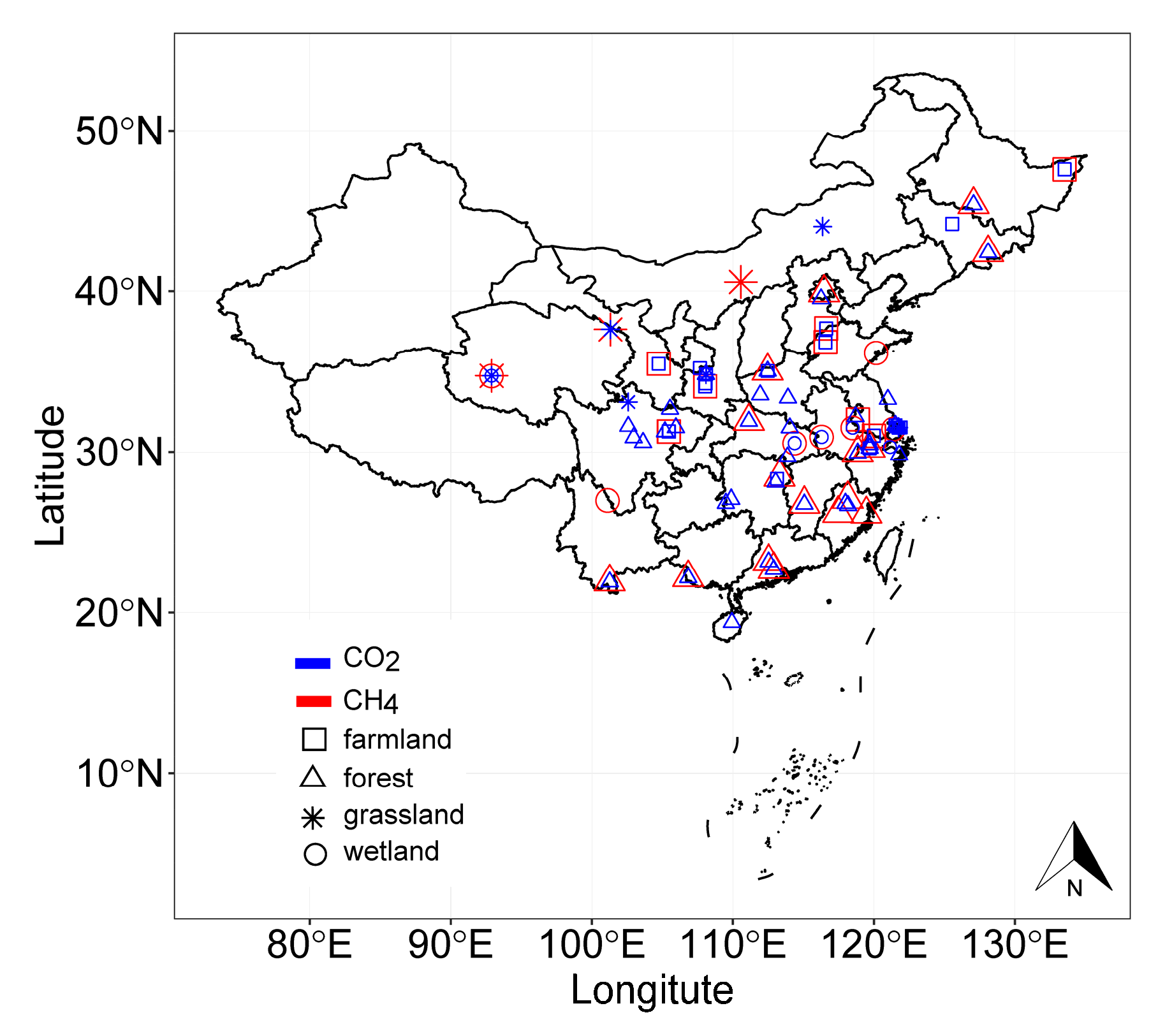

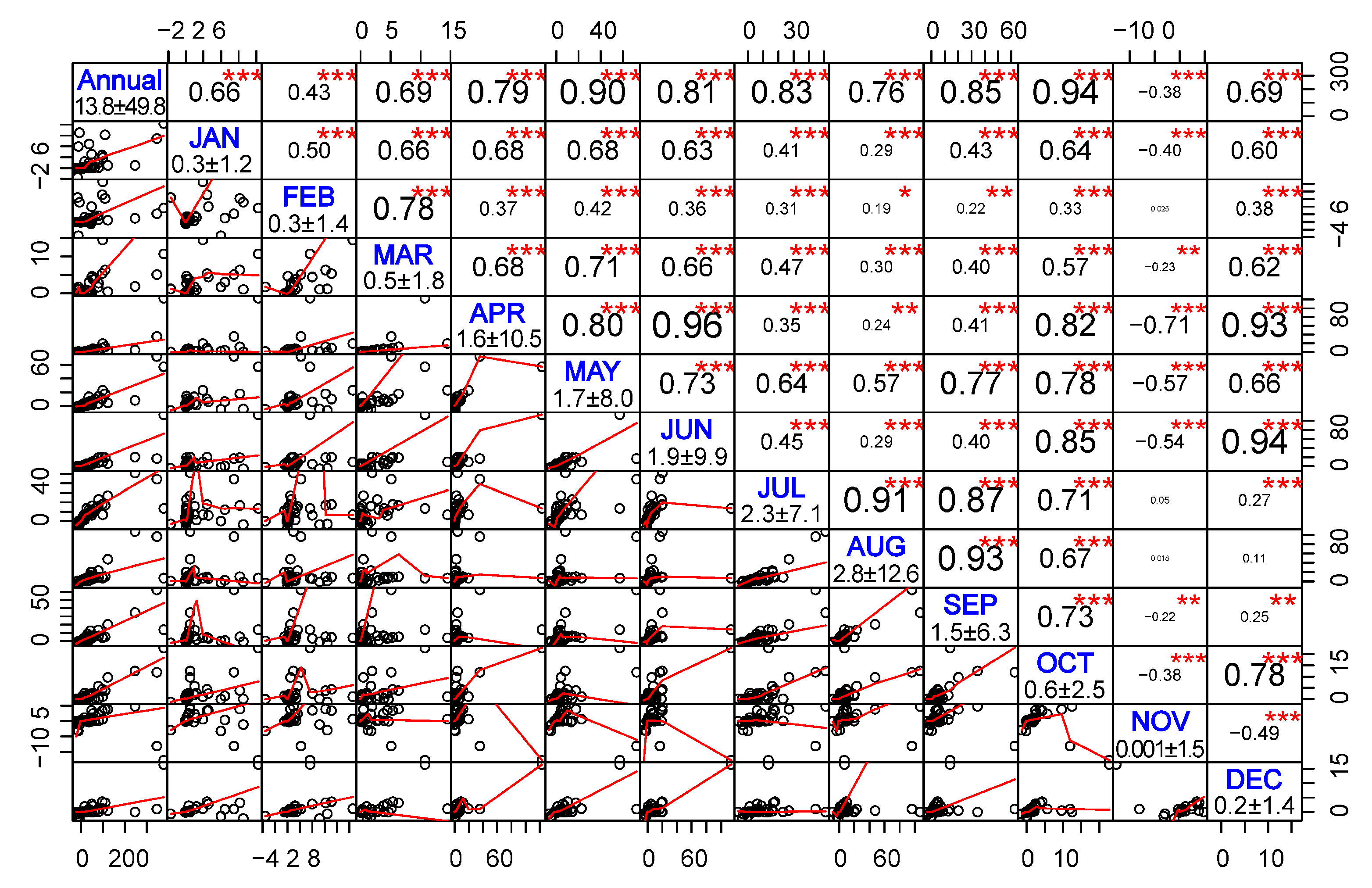
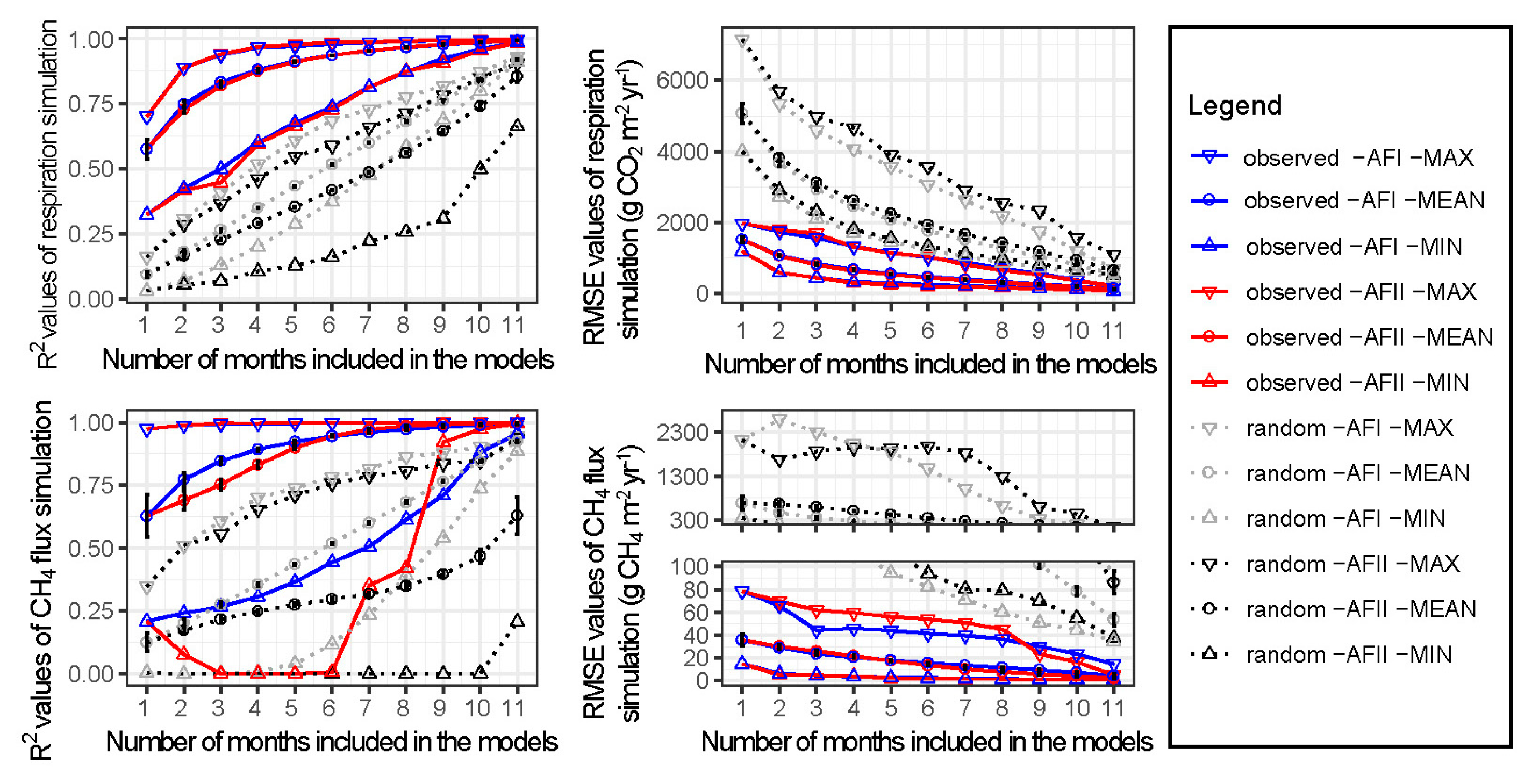
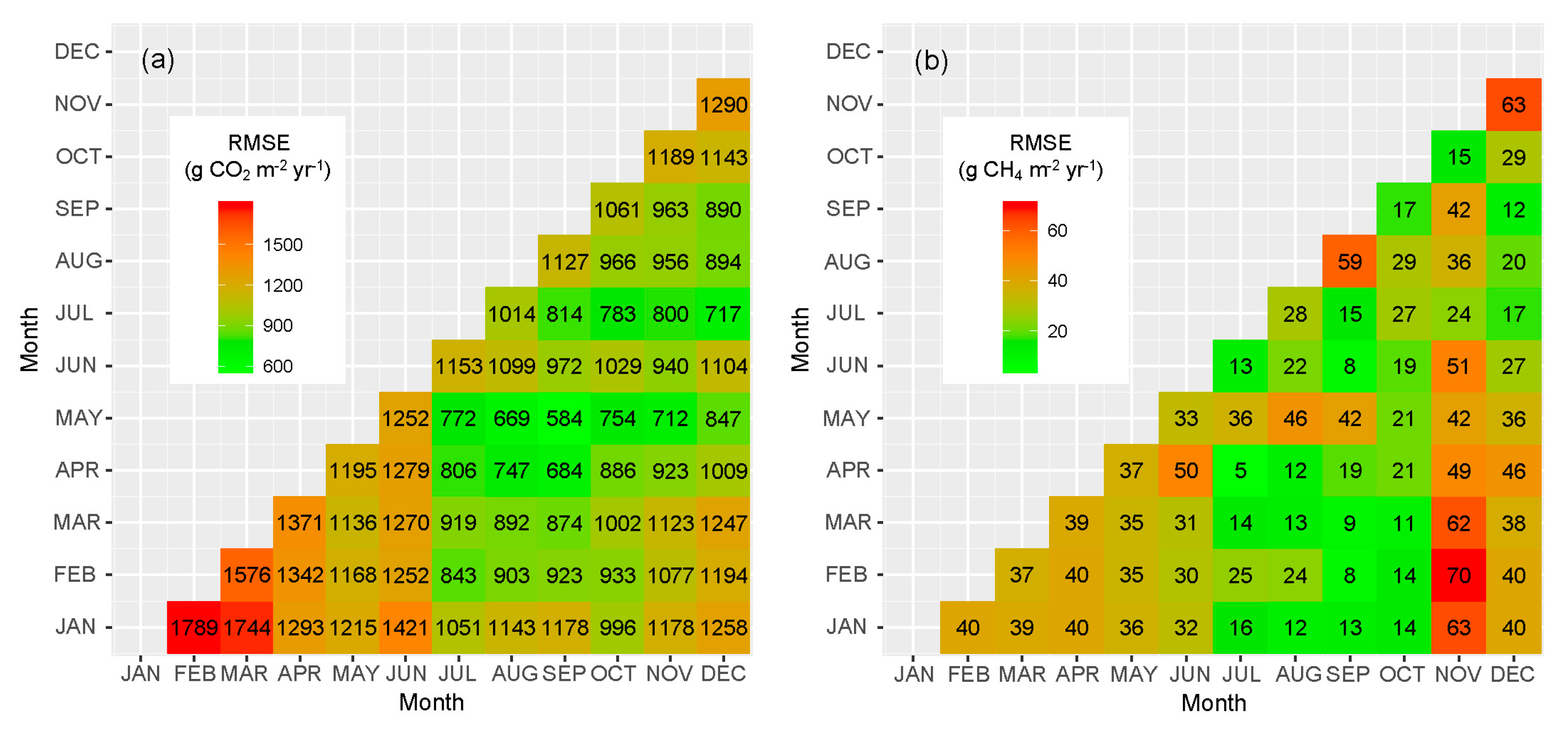
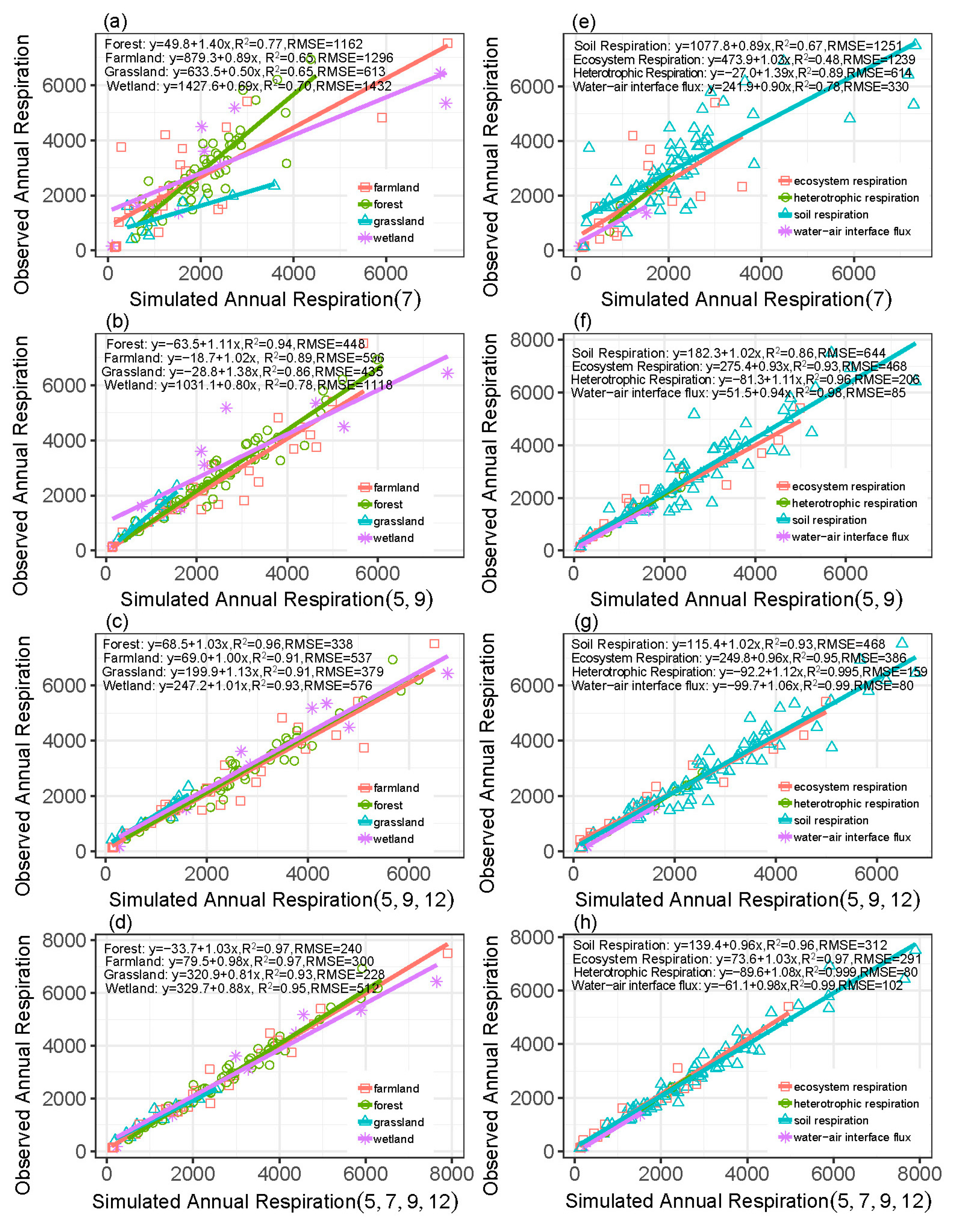
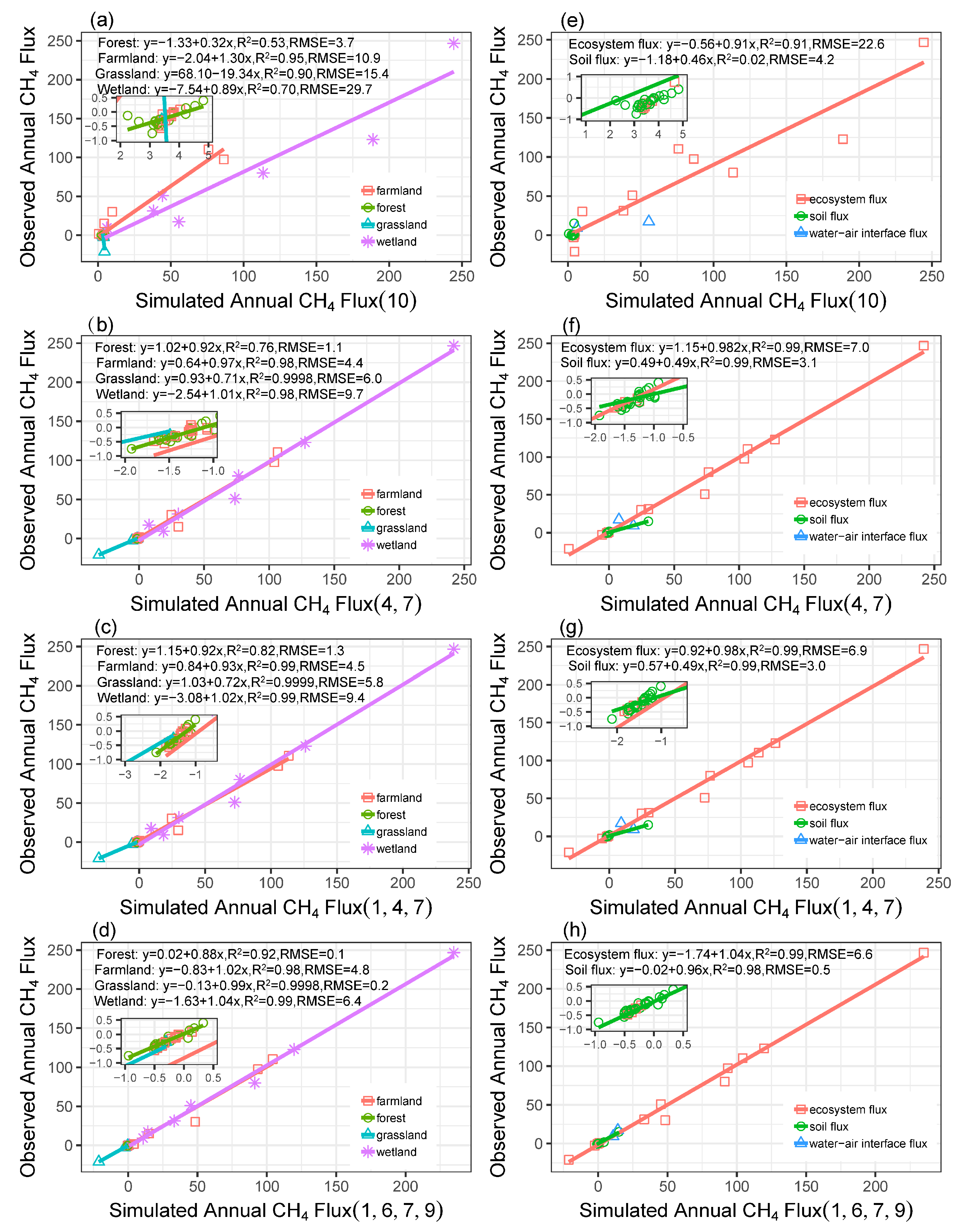
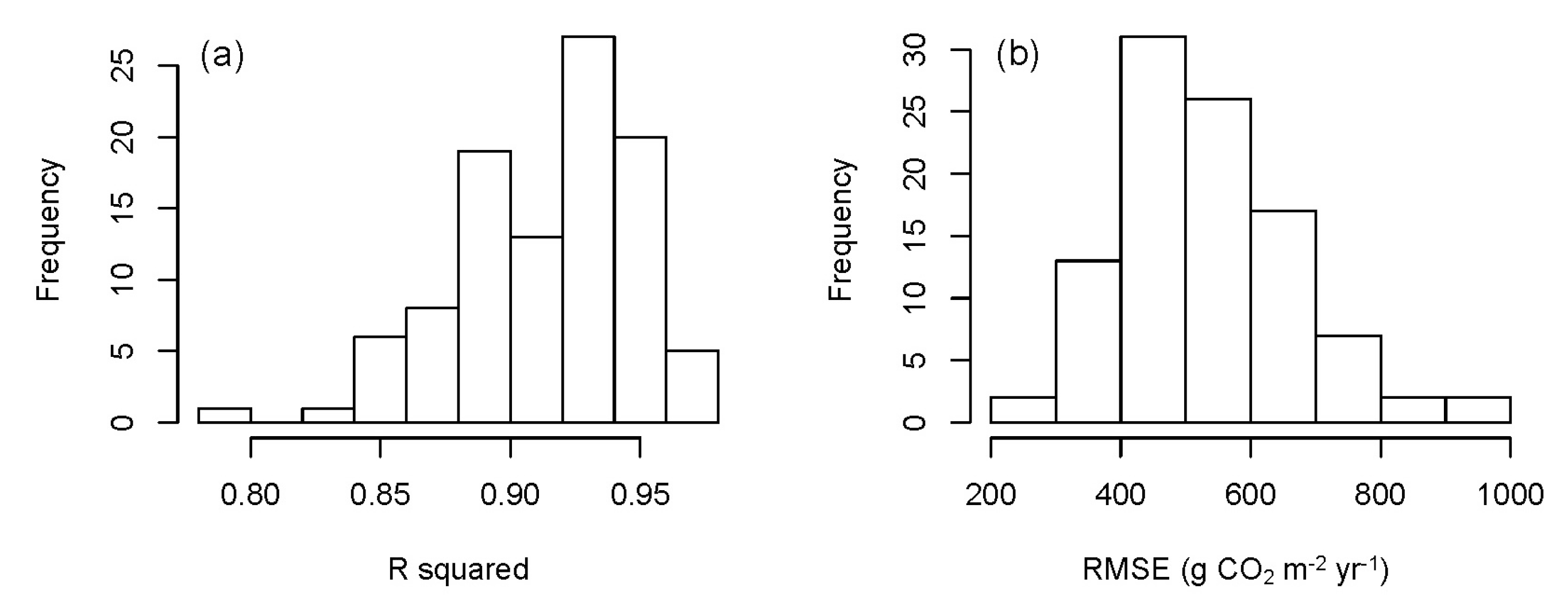
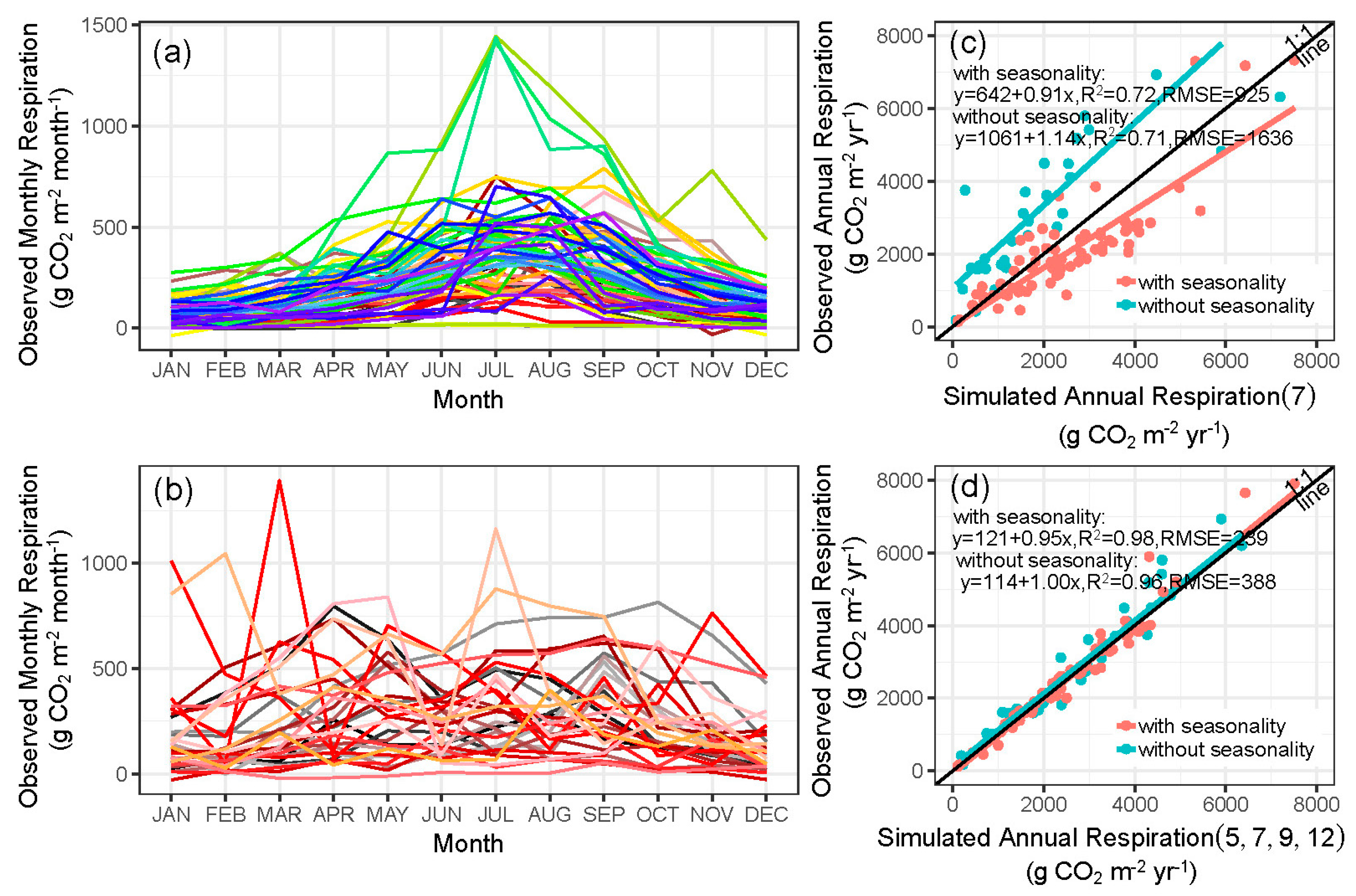

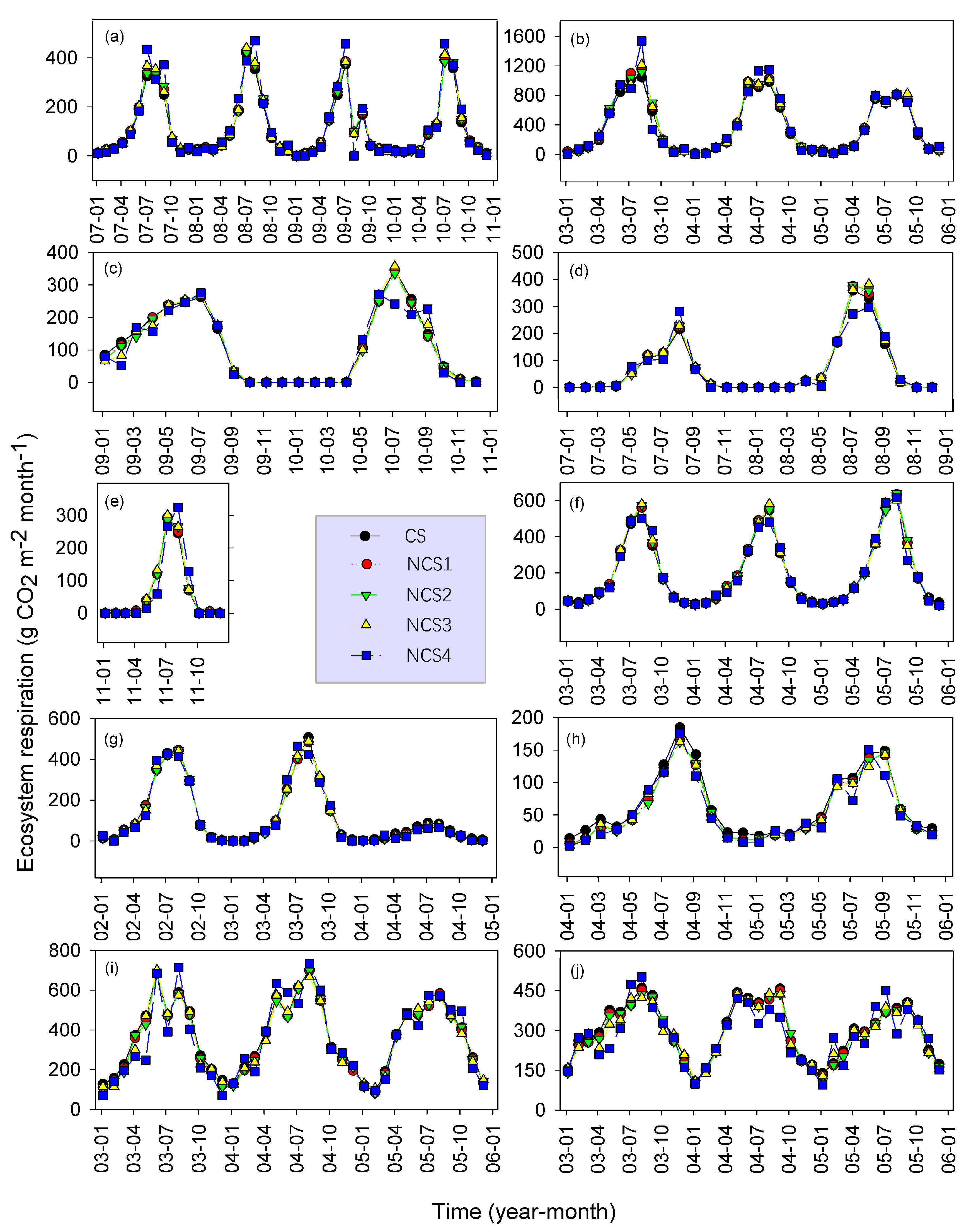
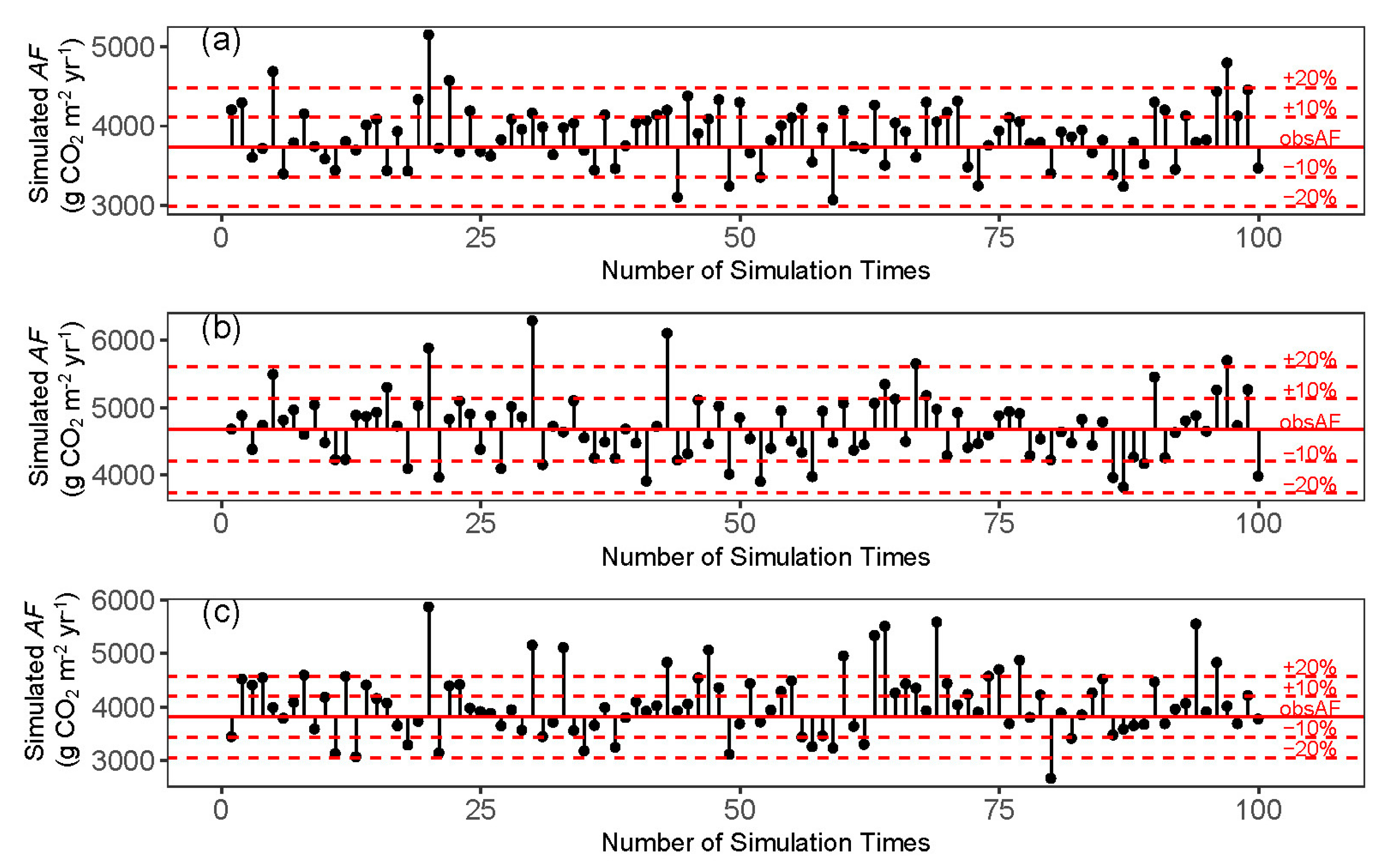
| Items | Soil/Ecosystem Respiration | CH4 Flux |
|---|---|---|
| Sample size (number of site-years) | 330 | 154 |
| Location | 19.4~47.6° N, 92.9~133.5° E | 19.4~47.6° N, 92.9~133.5° E |
| Chamber | Self-made or commercial transparent and opaque chamber | Self-made or commercial transparent and opaque chamber |
| Monitoring interface/sample size | Water/8, soil/255, soil with no roots/25, soil and plants/42 | Water/9, soil/107, soil and plants/38 |
| Ecosystem/sample size | Grassland/26, forest/188, farmland/96, wetland/20 | Grassland/8, forest/66, farmland/56, wetland/24 |
| Treatments or disturbances | Fertilization, straw incorporation, cover crop, rotation, rotational grazing, grazing, rain protection, root cutting, fire, herbicide application, harvesting, reclamation, increase and decrease of litter | Fertilization, straw incorporation, covering, crop rotation, rotational grazing, grazing, rain reduction, |
| Fluxes range | 14.0~7514.0 g CO2 m−2 yr−1 * | −21.0~377.6 g CH4 m−2 yr−1 |
| Mean ± standard deviation of fluxes | 1014 ± 1441 g CO2 m−2 yr−1 | 13.8 ± 49.8 g CH4 m−2 yr−1 |
| Median of fluxes | 321 g CO2 m−2 yr−1 | −0.16 g CH4 m−2 yr−1 |
| Site Name | Ecosystem | Latitude | Longitude | Duration | Mean ± Standard Deviation of Fluxes (g CO2 m−2 yr−1) | Median of Flux (g CO2 m−2 yr−1) |
|---|---|---|---|---|---|---|
| Changling | Grasslands | 44.6 | 123.5 | 2007–2010 | 1382 ± 135 | 1384 |
| Changbaishan | Mixed Forests | 42.4 | 128.1 | 2003–2005 | 4459 ± 432 | 4608 |
| Duolun Degraded Meadow | Grasslands | 42.1 | 116.3 | 2009–2010 | 1425 ± 9 | 1425 |
| Duolun Grassland | Grasslands | 42.0 | 116.3 | 2007–2008 | 881 ± 385 | 881 |
| Siziwang Grazed | Grasslands | 41.8 | 111.9 | 2011 | 798 | 798 |
| Haibei Shrubland | Permanent Wetlands | 37.6 | 101.3 | 2003–2005 | 2488 ± 178 | 2406 |
| Haibei Alpine Tibet | Grasslands | 37.4 | 101.2 | 2002–2004 | 1437 ± 858 | 1879 |
| Dangxiong | Grasslands | 30.5 | 91.1 | 2004–2005 | 809 ± 25 | 809 |
| Qianyanzhou | Evergreen Needleleaf Forests | 26.7 | 115.1 | 2003–2005 | 4402 ± 307 | 4282 |
| Dinghushan | Evergreen Broadleaf Forests | 23.2 | 112.5 | 2003–2005 | 3545 ± 97 | 3588 |
| Gas | Model | Number of Months Included in the Model | Equation No. | The Best Model | Training Data | Test Data | Equation No. | The Worst Model | Training Data | Test Data | ||||
|---|---|---|---|---|---|---|---|---|---|---|---|---|---|---|
| R2 | RMSE | R2 | RMSE | R2 | RMSE | R2 | RMSE | |||||||
| CO2 | Model AFII | 1 | B1 | AFsimCO2 = 71.901 + 5.021 * MF7 | 0.651 | 91 | 0.665 | 1186 | W1 | AFsimCO2 = 137.159 + 15.082 * MF1 | 0.528 | 106 | 0.349 | 1968 |
| 2 | B2 | AFsimCO2 = 22.282 + 5.086 * MF5 + 3.614 * MF9 | 0.902 | 48 | 0.889 | 584 | W2 | AFsimCO2 = 132.480 + 9.691 * MF1 + 5.063 * MF2 | 0.561 | 102 | 0.424 | 1789 | ||
| 3 | B3 | AFsimCO2 = 19.844 + 4.301 * MF5 + 2.993 * MF9 + 3.999 * MF12 | 0.928 | 41 | 0.941 | 431 | W3 | AFsimCO2 = 122.230 + 9.430 * MF1 + 2.506* MF2 + 2.885* MF3 | 0.579 | 100 | 0.449 | 1683 | ||
| 4 | B4 | AFsimCO2 = 3.443 + 3.250 * MF5 + 1.805 * MF7 + 2.090 * MF9 + 4.270 * MF12 | 0.971 | 26 | 0.969 | 292 | W4 | AFsimCO2 = 93.022 + 7.112 * MF1 + 1.660 * MF2 − 0.574 * MF3 + 5.188* MF4 | 0.692 | 85 | 0.597 | 1306 | ||
| CH4 | Model AFII | 1 | B5 | AFsimCH4 = 3.868 + 19.192 * MF10 | 0.870 | 18.5 | 0.915 | 14.8 | W5 | AFsimCH4 = 7.477 − 25.990 * MF11 | 0.626 | 31.3 | 0.906 | 78.5 |
| 2 | B6 | AFsimCH4 = −1.181 + 2.682 * MF4 + 4.530 * MF7 | 0.972 | 8.5 | 0.988 | 5.2 | W6 | AFsimCH4 = 5.033 + 9.092 * MF2 − 24.388 * MF11 | 0.689 | 28.6 | 0.893 | 69.6 | ||
| 3 | B7 | AFsimCH4 = −1.321 + 1.545 * MF1 + 2.582 * MF4 + 4.463 * MF7 | 0.973 | 8.4 | 0.988 | 5.0 | W7 | AFsimCH4 = 2.370 − 5.427 * MF2 + 15.394 * MF3 − 18.675 * MF11 | 0.813 | 22.1 | 0.792 | 62.0 | ||
| 4 | B8 | AFsimCH4 = −0.043 + 3.266 * MF1 + 2.514 * MF6 + 0.994 * MF7 + 3.793 * MF9 | 0.985 | 6.2 | 0.993 | 4.0 | W8 | AFsimCH4 = 2.093 + 3.361 * MF1 − 5.378 * MF2 + 14.480 * MF3 − 17.307 * MF11 | 0.817 | 21.9 | 0.636 | 59.5 | ||
| Groups | Random Dataset 1 | Random Dataset 2 | ||||
|---|---|---|---|---|---|---|
| R | p Value | Sample Size | R | p Value | Sample Size | |
| Group 1 | 0.21 | <0.001 | 330 | 0.27 | <0.01 | 154 |
| Group 2 | 0.34 | <0.001 | 330 | 0.28 | <0.001 | 154 |
| Group 3 | 0.28 | <0.001 | 330 | 0.32 | <0.001 | 154 |
| Group 4 | 0.31 | <0.001 | 330 | 0.33 | <0.001 | 154 |
| Group 5 | 0.35 | <0.001 | 330 | 0.15 | >0.05 | 154 |
| Group 6 | 0.34 | <0.001 | 330 | 0.38 | <0.001 | 154 |
| Group 7 | 0.25 | <0.001 | 330 | 0.19 | <0.05 | 154 |
| Group 8 | 0.30 | <0.001 | 330 | 0.37 | <0.001 | 154 |
| Group 9 | 0.24 | <0.001 | 330 | 0.20 | <0.05 | 154 |
| Group 10 | 0.29 | <0.001 | 330 | 0.41 | <0.001 | 154 |
| Group 11 | 0.34 | <0.001 | 330 | 0.16 | <0.05 | 154 |
| Group 12 | 0.31 | <0.001 | 330 | 0.29 | <0.001 | 154 |
© 2019 by the authors. Licensee MDPI, Basel, Switzerland. This article is an open access article distributed under the terms and conditions of the Creative Commons Attribution (CC BY) license (http://creativecommons.org/licenses/by/4.0/).
Share and Cite
Yang, M.; Yu, G.; He, N.; Grace, J.; Wang, Q.; Zhou, Y. A Method for Estimating Annual Cumulative Soil/Ecosystem Respiration and CH4 Flux from Sporadic Data Collected Using the Chamber Method. Atmosphere 2019, 10, 623. https://doi.org/10.3390/atmos10100623
Yang M, Yu G, He N, Grace J, Wang Q, Zhou Y. A Method for Estimating Annual Cumulative Soil/Ecosystem Respiration and CH4 Flux from Sporadic Data Collected Using the Chamber Method. Atmosphere. 2019; 10(10):623. https://doi.org/10.3390/atmos10100623
Chicago/Turabian StyleYang, Meng, Guirui Yu, Nianpeng He, John Grace, Qiufeng Wang, and Yan Zhou. 2019. "A Method for Estimating Annual Cumulative Soil/Ecosystem Respiration and CH4 Flux from Sporadic Data Collected Using the Chamber Method" Atmosphere 10, no. 10: 623. https://doi.org/10.3390/atmos10100623
APA StyleYang, M., Yu, G., He, N., Grace, J., Wang, Q., & Zhou, Y. (2019). A Method for Estimating Annual Cumulative Soil/Ecosystem Respiration and CH4 Flux from Sporadic Data Collected Using the Chamber Method. Atmosphere, 10(10), 623. https://doi.org/10.3390/atmos10100623





